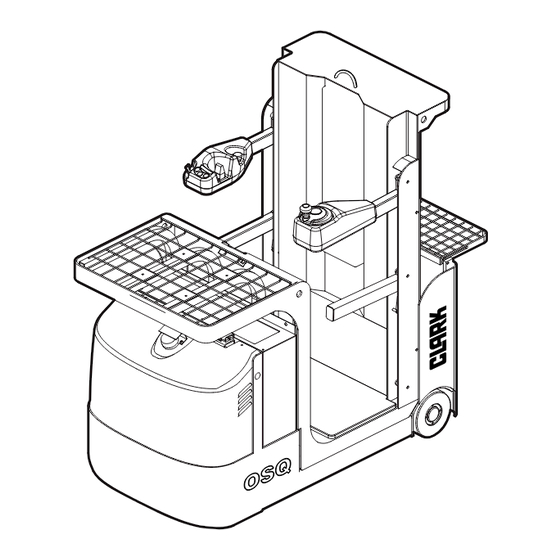
Summarization of Contents
Introduction
Foreword
Welcome to CLARK, overview of the manual and vehicle.
Routine Servicing and Maintenance
Importance of regular maintenance for safety and economy.
General Safety Rules
Daily Inspection
Procedure for performing a daily safety inspection of the vehicle.
Do's and Don'ts
Guidelines for safe operation and prohibited actions.
No Riders
Warning against carrying passengers on the vehicle.
No Lifting Personnel
Warning against using the vehicle to raise personnel.
Travel and Grades
Instructions for safe travel on inclines and level surfaces.
Watch for Pedestrians
Emphasis on being aware of pedestrians in the work area.
No Climbing
Warning against climbing on vehicle parts or climbing down from the platform.
Platform Safety
Safety precautions related to the operator platform, including blocking.
Safe Parking
Procedure for safely parking the vehicle.
Pinch Points
Warning about hazardous pinch points on the vehicle.
Operating Hazards
Fast Turns
Warning about tip-over risk with fast turns, especially when empty.
Corners
Caution regarding rear 'tail-swing' when turning corners.
Loose Loads
Hazards of carrying loose or unbalanced loads and how to secure them.
Falling Objects
Warning about falling objects from the elevated platform.
Overhead Clearance
Caution regarding low ceilings and overhead obstructions.
Debris on the Floor
Hazards posed by floor debris like oil, ice, and mud.
Transporting Loads
Guidelines for safely transporting loads, including capacity limits.
Tether and Safety Harness
Requirement to use tether and safety harness at elevated heights.
Know Your Vehicle
System Descriptions
Overview of general vehicle, chassis, controls, and drive unit.
Vehicle Components
Identification and illustration of major vehicle components.
Operator Controls
Description and location of all operator controls.
Display
Explanation of dashboard display indicators and symbols.
Screen
Detailed breakdown of screen elements and their meanings.
Data Plate
Information and importance of the vehicle's data plate.
Warning Decals
Examples and meaning of safety decals on the vehicle.
Operating Your Vehicle
Beginning Operation
Pre-operation checks and starting procedures for the vehicle.
Travel Control
Instructions for steering and traveling, including speed control.
Braking
Explanation of the three braking methods: reverse, coast, and emergency.
Lifting and Lowering
Operation of lift and lower controls, including horn usage.
Load Handling
Procedures for picking, transporting, and placing loads safely.
Emergency Lowering
Procedure for manually lowering the operator platform in emergencies.
Storing Rear Tray
Instructions on how to store the rear tray.
Parking
Procedure for safely parking the vehicle.
Daily Inspection
Daily Inspection Sheet
Checklist for daily pre-operation inspection.
Check Horn
Procedure for verifying the proper operation of the horn.
Check Emergency Stop Switch
Procedure for testing the emergency stop switch functionality.
Check Steering Tiller
Procedure for checking the steering tiller for smooth operation.
Check Travel Control
Procedure for testing the vehicle's travel controls.
Check Lift and Lower Controls
Procedure for checking the lift and lower control functions.
Check Braking
Procedure for checking the vehicle's braking systems.
Check Upright and Lift Chains
Inspection of upright and lift chains for wear and damage.
Check Wheels and Tires
Inspection of wheels and tires for wear and damage.
Maintenance Issues
Procedure for handling vehicles with maintenance issues.
Planned Maintenance
Safe Maintenance Practices
Safety guidelines for performing maintenance on the vehicle.
Typical Operating Conditions
Defining normal and severe operating conditions affecting service intervals.
Required Inspections
Information on frequent and annual vehicle inspection requirements.
Planned Maintenance Schedule
Maintenance schedule table for checks, cleaning, lubrication, and replacement.
Lubrication Points
Identification of lubrication points and their service intervals.
Cleaning the Vehicle
Procedures and precautions for cleaning the vehicle.
Welding on the Vehicle
Precautions to take before welding on the vehicle.
Tire and Wheel Maintenance
Guidelines for tire and wheel maintenance and replacement.
Hydraulic Hoses
Recommendation for hydraulic hose replacement intervals.
Battery Maintenance
Procedures for battery maintenance, charging, and handling.
Storage and Towing
Storing the Vehicle
Actions to take when storing the vehicle for extended periods.
Towing and Transporting
Procedures for safely towing and transporting the vehicle.
Tow Hitch (Optional)
Instructions for using the optional tow hitch.
Specifications
Vehicle Dimensions
Detailed diagrams and measurements of the vehicle's dimensions.
Capacity
Information on lifting capacities for different configurations.
Travel Speed and Lift Height
Table detailing travel speeds and lift height specifications.
Recommended Lubricants
Table of recommended lubricants and their part numbers.
Battery Specifications
Specifications for the vehicle's battery system.


Need help?
Do you have a question about the OSQ 162 and is the answer not in the manual?
Questions and answers